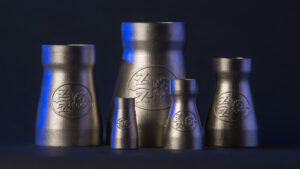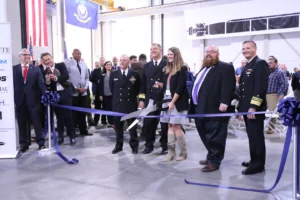Naval Sea Systems Command (NAVSEA) recently gave HII’s Newport News Shipbuilding (NNS) [HII] approval to use some 3D-printed parts, also called additive manufacturing, on aircraft carriers, submarines and other platforms.
This latest certification will allow the company to use additive manufacturing to fabricate pipe fittings and potentially other components. Specifically, HII said this is for stainless steel (316/316L grade) additively manufactured pipe fittings.

NNS spokesman Todd Corillo told Defense Daily while the latest approval is related to a specific fitting type, “our broader approval enables us to submit additional part approvals to the Navy for potential integration into their platforms.”
Corillo said this approval now gives the company “an avenue to provide additively manufactured parts to all naval platforms that can leverage the material.”
NAVSEA first approved the technical standards for 3D printing in 2018 after collaborating with HII and other industry partners. The company said that initial process entailed “the rigorous printing of test parts and materials, extensive development of an engineered test program and publishing of the results.”
The first NSS 3D-printed metal part was a piping assembly delivered to the Navy in January 2019 before it was installed on the HII-built USS Harry S. Truman (CVN-75).
Following that initial work, HII said NSS has received approval for “several other” metal additive manufactured parts on Navy ships of “varying criticality.”
Corillo confirmed that, thus far, NAVSEA has only approved NNS to use one machine to produce additive manufacturing parts. However, he said the latest approval now gives HII “the opportunity to scale-up our additive manufacturing production efforts in support of production demand signals, potentially extending that qualification to other machines, and to support other schedule needs.”
He argued that Newport News Shipbuilding has been working on additive manufacturing technologies for over 15 years, having performed “numerous feasibility studies” to evaluate its capabilities while successful pilot projects helped the company “spur additional use-cases and unlock the creativity of our workforce.”
Corillo noted an example of how current 3D printing is already saving time is when the Navy approved additive manufacturing of some specific door hinges on the next Ford-class aircraft carrier, the future USS Enterprise (CVN-80).

“NNS, working with our partners, produced the parts in less than eight weeks. It would typically take five to six months using traditional casting methods,” Corillo said.
Now the company said it is next seeking approvals that will allow broader use and implementation of 3D printing across the naval enterprise. HII argued this kind of highly digitized process could result in cost savings and shortened production schedules for ships.
“In general, we have observed that additive manufacturing can offer enhanced schedule production benefits in a cost-effective manner,” Corillo said.
In January, Program Executive officer for Strategic Submarines Matt Sermon said the Navy was investing in producing metal parts via additive manufacturing, with a focus on castings, forgings, fittings, valves and fasteners. He said if the supply chain transitions to relying on more parts made this way, it could potentially lead to a 50 to 95 percent reduction in schedules for components at new construction shipyards, like NNS (Defense Daily, Jan. 31).
Corillo also said while right now each instance of additive manufacturing requires individual analysis, the company is pursuing “broader approaches to additive manufacturing part qualification.”
“We believe the foundational efforts NNS has accomplished, coupled with Navy approvals we have obtained, has positioned us well to support both the Navy and our supply base,” he continued.
Corillo said as HII moves forward with implementing 3D printing across the NNS shipyard, they expect to use a combination of both in-house additively manufactured components and those made at partner facilities.
“While the rate of manufacturing varies based on requirements, we are confident we will continue to see improved product quality compared to traditional castings, and reduced production time,” he said.